Samsung WB09H7300GW, WB09H7300GP Product Manual
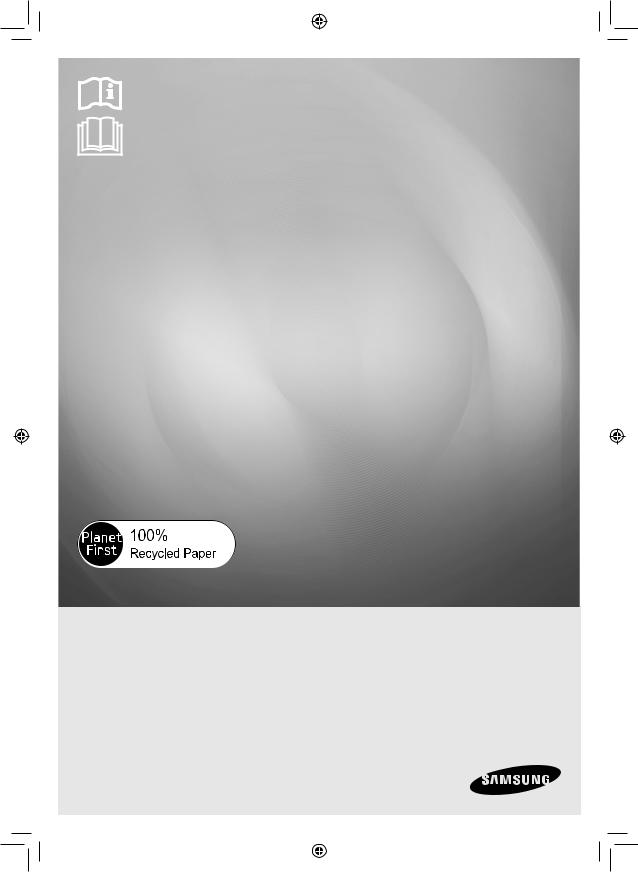
WB09H7*****
Washing machine
User manual
This manual is made with 100 % recycled paper.
Imagine the possibilities
Thank you for purchasing this Samsung product.
Untitled-2 1 |
|
|
2014-05-26 10:51:07 |
|
|
||
|
|
|
|

Content
Safety information |
3 |
Icons and symbols used in this manual . . . . . . . . . . . . . . . . . . . . . . . . . . . . . . . . . . . . . . . . . . 3 Important safety instructions . . . . . . . . . . . . . . . . . . . . . . . . . . . . . . . . . . . . . . . . . . . . . . . . . . 5 Location requirements. . . . . . . . . . . . . . . . . . . . . . . . . . . . . . . . . . . . . . . . . . . . . . . . . . . . . . . 6
Installation |
7 |
What’s included. . . . . . . . . . . . . . . . . . . . . . . . . . . . . . . . . . . . . . . . . . . . . . . . . . . . . . . . . . . . 7 Installation requirements. . . . . . . . . . . . . . . . . . . . . . . . . . . . . . . . . . . . . . . . . . . . . . . . . . . . . . 8 Step-by-step installation. . . . . . . . . . . . . . . . . . . . . . . . . . . . . . . . . . . . . . . . . . . . . . . . . . . . . 12
Basic operations |
21 |
Laundry guidelines. . . . . . . . . . . . . . . . . . . . . . . . . . . . . . . . . . . . . . . . . . . . . . . . . . . . . . . . . 21 Detergent types and usage . . . . . . . . . . . . . . . . . . . . . . . . . . . . . . . . . . . . . . . . . . . . . . . . . . 24 When to add fabric softener. . . . . . . . . . . . . . . . . . . . . . . . . . . . . . . . . . . . . . . . . . . . . . . . . . 24 Handling the secure door. . . . . . . . . . . . . . . . . . . . . . . . . . . . . . . . . . . . . . . . . . . . . . . . . . . . 24 About the sanitizing wash cycle. . . . . . . . . . . . . . . . . . . . . . . . . . . . . . . . . . . . . . . . . . . . . . . 25 Getting started. . . . . . . . . . . . . . . . . . . . . . . . . . . . . . . . . . . . . . . . . . . . . . . . . . . . . . . . . . . . 26
Maintainence |
31 |
Cleaning the exterior.. . . . . . . . . . . . . . . . . . . . . . . . . . . . . . . . . . . . . . . . . . . . . . . . . . . . . . . 31 Keeping the tub clean . . . . . . . . . . . . . . . . . . . . . . . . . . . . . . . . . . . . . . . . . . . . . . . . . . . . . . 31 Cleaning the water hose mesh filters . . . . . . . . . . . . . . . . . . . . . . . . . . . . . . . . . . . . . . . . . . . 32 Cleaning the Tub Filter. . . . . . . . . . . . . . . . . . . . . . . . . . . . . . . . . . . . . . . . . . . . . . . . . . . . . . 33
Troubleshooting |
34 |
Check the table below for basic troubleshooting solutions. . . . . . . . . . . . . . . . . . . . . . . . . . . 34 Information codes . . . . . . . . . . . . . . . . . . . . . . . . . . . . . . . . . . . . . . . . . . . . . . . . . . . . . . . . . 36
Cycle chart
Specifications
37
38
Helping the environment. . . . . . . . . . . . . . . . . . . . . . . . . . . . . . . . . . . . . . . . . . . . . . . . . . . . . 38 Declaration of conformity. . . . . . . . . . . . . . . . . . . . . . . . . . . . . . . . . . . . . . . . . . . . . . . . . . . . 38 Specifications. . . . . . . . . . . . . . . . . . . . . . . . . . . . . . . . . . . . . . . . . . . . . . . . . . . . . . . . . . . . . 38
Warranty |
39 |
Warranty (U.S.A). . . . . . . . . . . . . . . . . . . . . . . . . . . . . . . . . . . . . . . . . . . . . . . . . . . . . . . . . . . 39
Warranty (CANADA). . . . . . . . . . . . . . . . . . . . . . . . . . . . . . . . . . . . . . . . . . . . . . . . . . . . . . . . 41
English - 2
Untitled-2 2 |
|
|
2014-05-26 10:51:07 |
|
|
||
|
|
|
|
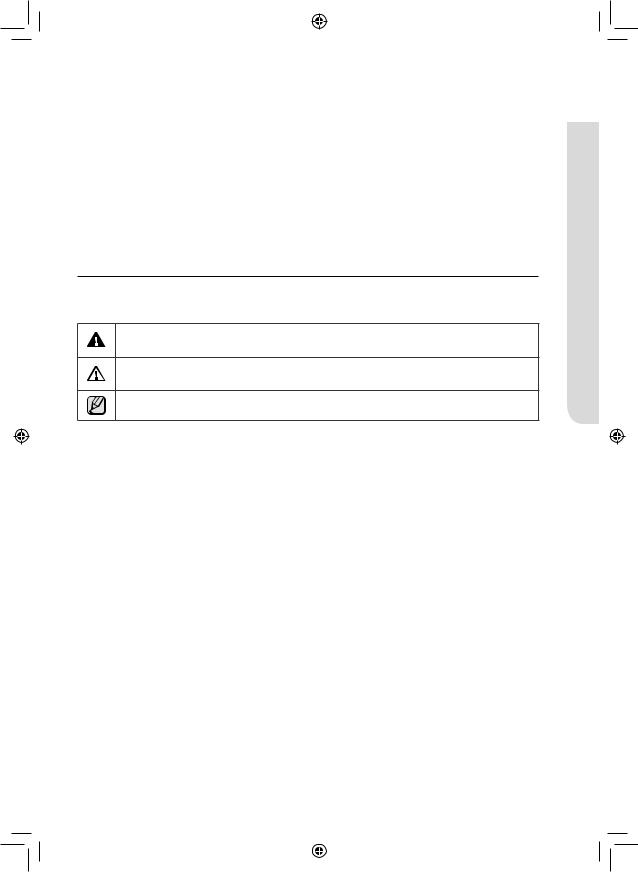
Safety information
Throughout this manual, you’ll see warning and caution symbols. These warnings, cautions, and the important safety instructions that follow do not cover all possible conditions and situations that may occur. It’s your responsibility to use common sense and caution when installing, maintaining, and operating your washer. Samsung is not liable for any damage resulting from improper use.
The product you have purchased is designed for domestic use only. Using the product for business purposes qualifies as a product misuse. If the product is used for business purposes, it will not be covered by the standard warranty provided by Samsung and no responsibility will be attributed to Samsung for any damage or malfunctions resulting from such misuse.
Icons and symbols used in this manual
These warning signs are here to prevent injury to yourself and others.
Please follow them explicitly.
WARNING: Hazards or unsafe practices that may result in severe physical injury, death and/or property damage.
CAUTION: Hazards or unsafe practices that may result in physical injury and/or property damage.
NOTE
Read all instructions before using the appliance.
As with any equipment that uses electricity and moving parts, potential hazards exist. To safely operate this appliance, familiarize yourself with its operation and exercise care when using it.
SAVE THESE INSTRUCTIONS
English - 3
<![endif]> INFORMATION SAFETY
INFORMATION SAFETY
Untitled-2 3 |
|
|
2014-05-26 10:51:08 |
|
|
||
|
|
|
|
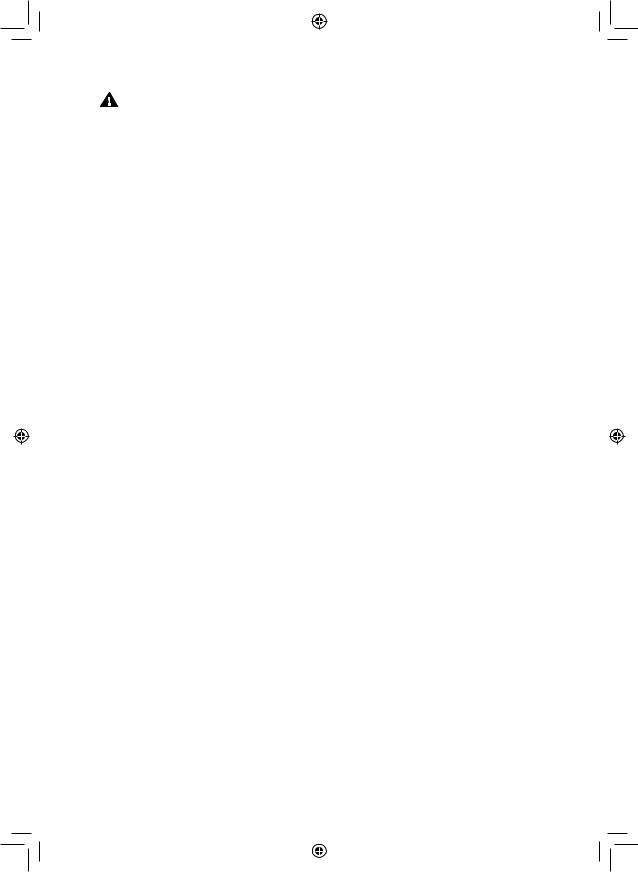
WARNING: To reduce the risk of fire, electric shock, or injury to persons when using your appliance, follow basic precautions, including the following:
1.Read all instructions before using the appliance.
2.Do not wash or dry articles that have been previously cleaned in, washed in, soaked in, or spotted with gasoline, dry-cleaning solvents, other flammable or explosive substances as they give off vapors that could ignite or explode.
3.Do not allow children to play on or in the appliance. Close supervision of children is necessary when the appliance is used near children.
4.Before the appliance is removed from service or discarded, remove the door to the washing or drying compartment.
5.Do not reach into the appliance if the drum is moving.
6.Do not install or store this appliance where it will be exposed to the weather.
7.Do not tamper with controls.
8.Do not repair or replace any part of the appliance or attempt any servicing unless specifically recommended in the user-maintenance instructions or in published user-repair instructions that you understand and have the skills to carry out.
9.Do not add gasoline, dry-cleaning solvents, or other flammable or explosive substances to the wash water. These substances give off vapors that could ignite or explode.
10.Under certain conditions, hydrogen gas may be produced in a hot water system that has not been used for 2 weeks or more. HYDROGEN GAS IS EXPLOSIVE. If the hot water system has not been used for such a period, before using a washer or combination washer-dryer, turn
on all hot water faucets and let the water flow from each for several minutes. This will release any accumulated hydrogen gas. As the gas is flammable, do not smoke or use an open flame during this time.
WARNING: This product contains chemicals known to the State of California to cause cancer and reproductive toxicity.
SAVE THESE INSTRUCTIONS
English - 4
Untitled-2 4 |
|
|
2014-05-26 10:51:08 |
|
|
||
|
|
|
|

Important safety instructions
WARNING: For safety reasons, read through the following instructions before installing or using the washer.
Do not attempt to repair, disassemble, or modify your washer. For any repairs, contact your nearest Samsung service center.
Do not wash items contaminated with gasoline, kerosene, solvents, or any other flammable substances.
Do not install the washer in a location exposed to extreme temperatures, high-humidity levels, and/ or the weather.
Do not let children or pets play in, on, or around the washer. Proper supervision is necessary at all times.
Do not move the washer while it’s operating.
Do not use the washer if the washer or any parts of the washer are damaged. Keep all packaging materials away from children.
Do not put your hands or any objects in or under the washer while the washer is operating.
Do not replace a damaged power cord or power plug yourself. Have Samsung or a qualified service technician replace a damaged power cord or power plug.
Before disposing of your washer, remove the lid.
SAVE THESE INSTRUCTIONS
English - 5
<![endif]> INFORMATION SAFETY
INFORMATION SAFETY
Untitled-2 5 |
|
|
2014-05-26 10:51:08 |
|
|
||
|
|
|
|
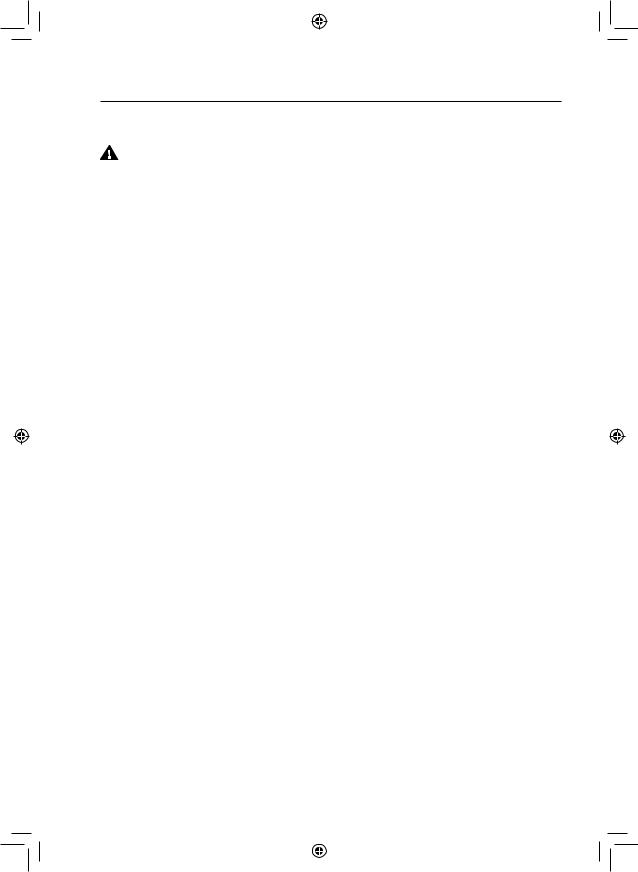
Location requirements
To ensure safe and proper installation and use of your washer, follow these guidelines for selecting a location.
WARNING:
•Use caution when lifting or moving the washer.
•Do not install the washer in areas exposed to the weather.
•Do not install the washer in areas where the ambient temperature may drop below 32 °F (0 °C).
•Keep the washer away from electrical devices.
•Do not install the washer in a location where gas may leak.
•Do not install the washer near a heater or flammable material.
Select a level, well-constructed surface that does not have carpeting or flooring that may obstruct ventilation or contribute to vibrations.
Select a location where a grounded, 3-prong socket is easily accessible.
For the provided water hoses to reach the washer, make sure the water taps are within 120 cm (4 ft) of the back of the washer.
SAVE THESE INSTRUCTIONS
English - 6
Untitled-2 6 |
|
|
2014-05-26 10:51:08 |
|
|
||
|
|
|
|
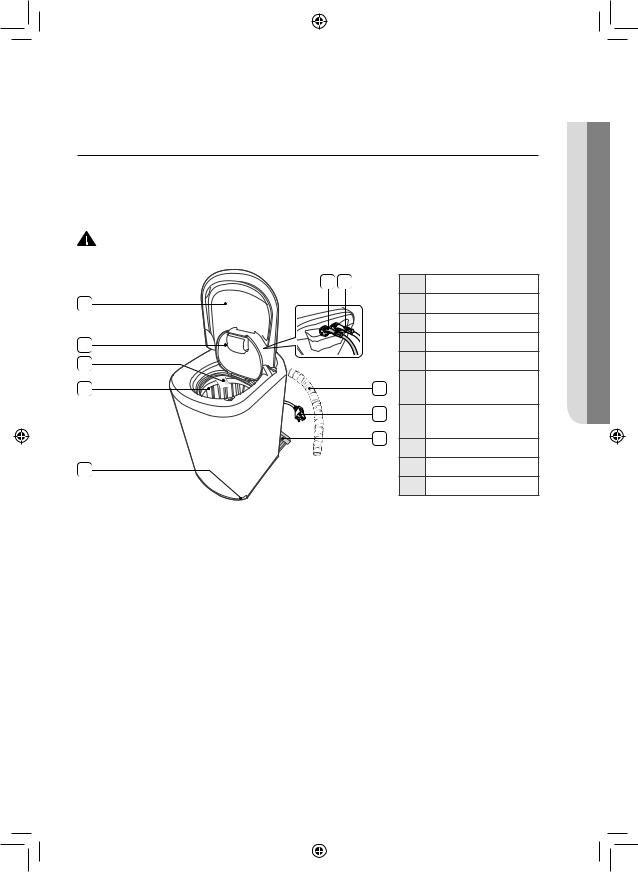
Installation
What’s included
Carefully unpack the washer, and make sure you’ve received all the parts shown below. If the washer was damaged during delivery, or if you do not have all the parts, contact a local Samsung customer service center (1-800-SAMSUNG (726-7864)) or your Samsung retailer.
To prevent personal injury, wear protective gloves when lifting or carrying the washer.
WARNING: Packaging materials can be dangerous to children. Keep all packaging material (plastic bags, polystyrene, etc.) out of children’s reach.
6 7 |
|
1 |
Door lid |
|
1 |
|
2 |
Secure door lid |
|
|
|
3 |
Filter |
|
2 |
|
4 |
Tub |
|
3 |
|
5 |
Levelling feet |
|
4 |
8 |
6 |
Cold water supply |
|
hose |
||||
|
|
|
||
|
9 |
7 |
Hot water supply |
|
|
|
hose |
||
|
10 |
|
||
|
8 |
Drain hose |
||
|
|
|||
5 |
|
9 |
Power cord |
|
|
|
10 |
Baffle board |
English - 7
<![endif]> INSTALLATION
INSTALLATION
Untitled-2 7 |
|
|
2014-05-26 10:51:08 |
|
|
||
|
|
|
|
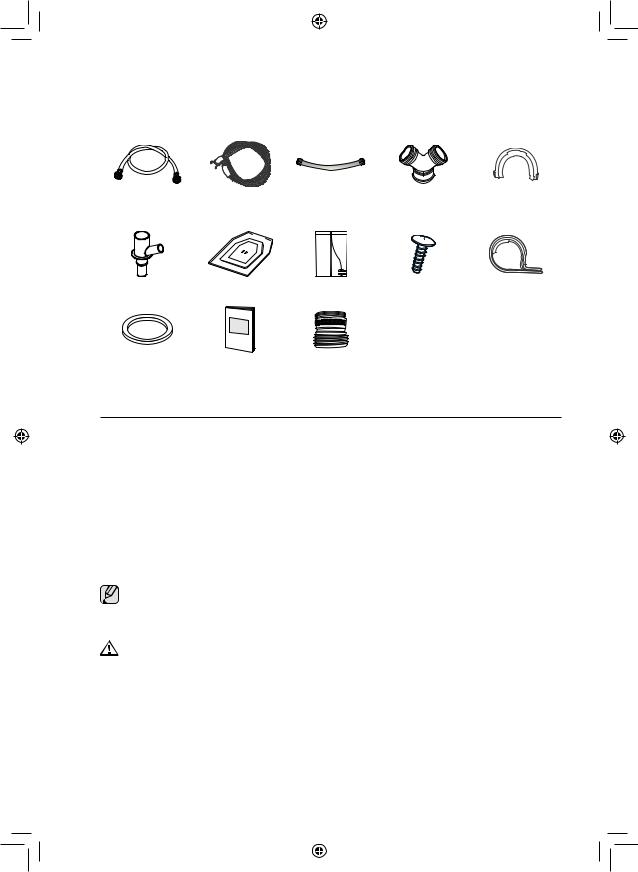
Accessories
The water supply hose and the drain hose (extension hose) can be purchased at a local Samsung service center.
Water supply hose |
Drain hose |
Short inlet hose (2) “Y”-connector (2) |
Hose guide |
(2) |
|
|
|
Drain adaptor |
Baffle board |
Leveling device |
Screw |
Clamper |
Rubber washer (2) |
User manual |
Tap connector |
Installation requirements
Water Supply
•To correctly fill your washer in the proper amount of time, water pressure of 20 to 116 psi (137 to 800 kPa) is required. Water pressure less than 20 psi may cause water valve failure, may not allow the water valve to shut off completely, or may extend the fill time beyond what your washer controls allow, causing your washer to turn off. A time limit is built into the controls to prevent flooding in your home if a hose becomes loose.
•For the provided water hoses to reach the washer, make sure the water taps are within 120 cm (4 ft) of the back of the washer.
•Before using for the first time, check all connections at the water valves and taps for any leaks.
To reduce a risk of water leaks:
•Make sure the water taps are easily accessible.
•Turn off the water taps when the washer is not in use.
CAUTION: Check all connections at the water valves and taps for any leaks.
English - 8
Untitled-2 8 |
|
|
2014-05-26 10:51:09 |
|
|
||
|
|
|
|
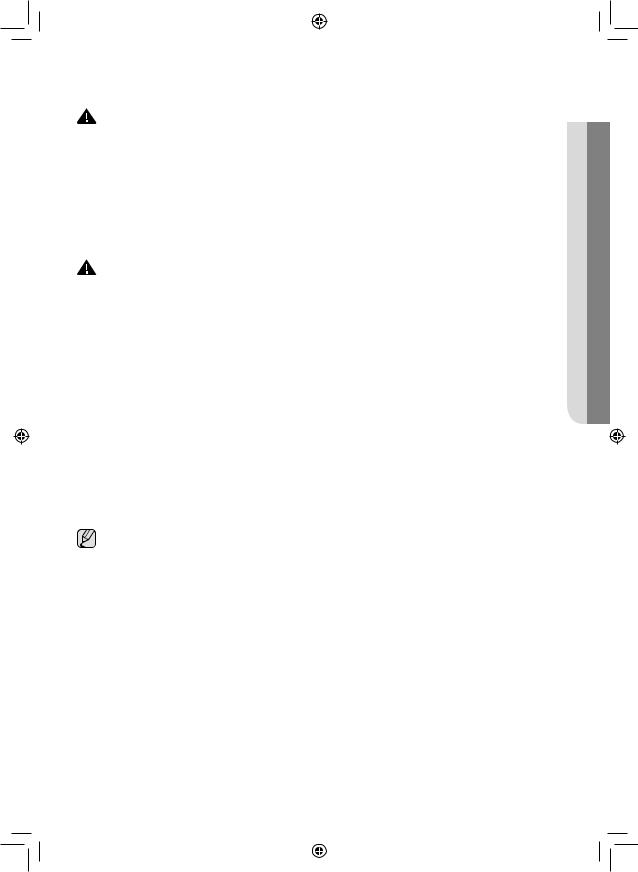
Power supply
WARNING: To reduce the risk of fire, electric shock, personal injury, or property damage when using the washer, follow these basic precautions:
•Connect the washer to an individual branch circuit that:
•Has a 120 V /60 Hz, 15 AMP fuse or circuit breaker.
•Will serve only the washer.
•Do not use an extension cord.
•Use only the power cord that comes with your washer.
Grounding
WARNING: To reduce the risk of fire, electric shock, personal injury, or property damage when using the washer, follow the basic precautions.
For safety, the washer must be grounded.
•The washer must be properly grounded. After a malfunction or breakdown of the machine, proper grounding will reduce the risk of electric shock by providing minimum resistance to the electric current.
•The washer comes with a power cord that has a three-prong grounding plug for use in a properly installed and grounded socket.
•Do not modify the plug that comes with the washer. If it does not fiit the socket, have a proper socket installed by a qualified electrician.
•Improper connection of the grounding conductor may cause electric shock. To confirm the washer is properly grounded, check with a qualified electrician or service person.
•To prevent a risk of fiire, electrical shock, or physical injury, all wiring and grounding must be performed in accordance with the National Electrical Code ANSI/FNPA, No. 70 Latest Revision and local codes and ordinances. It is the owner’s responsibility to accommodate adequate electrical power for this product.
•Do not connect the ground wire to plastic plumbing lines, gas lines, or hot water pipes.
If grounding is not available, add a circuit breaker between the wall socket and the washer instead.
English - 9
<![endif]> INSTALLATION
INSTALLATION
Untitled-2 9 |
|
|
2014-05-26 10:51:09 |
|
|
||
|
|
|
|
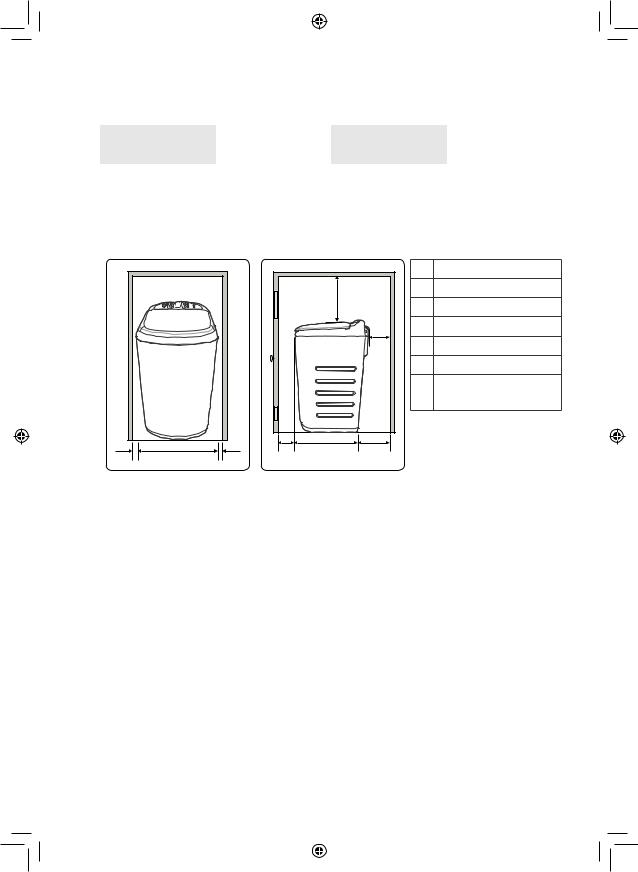
Alcove or closet installation
Minimum clearances for closet or alcove installations:
Sides |
1 in / 25 mm |
Rear |
6 in / 152 mm |
|
|
|
|
Closet front |
2 in / 51 mm |
Top |
21 in / 533 mm |
|
|
|
|
The space between the end of the water valve and the wall:
•Case 1. If you connect the supply hoses after setting the washer in place: Over 3.9 in (10 cm).
•Case 2. If you connect the supply hoses before setting the washer in place: Over 2.8 in (7 cm).
If the washer and a dryer are installed together, the closet or alcove front must have at least a 72 in² (465 cm²) unobstructed air opening. The washer alone does not require a specific air opening.
|
A 1 in. (25 mm) |
||
C |
B 17.7 in. (450 mm) |
||
C |
21 in. (533 mm) |
||
|
|||
|
D |
2 in. (51 mm) |
|
G |
E |
20.9 in. (530 mm) |
|
|
F |
6 in. (152 mm) |
|
|
G |
Case 1: 3.9 in (10 cm). |
|
|
Case 2: 2.8 in (7 cm). |
||
A |
B |
A |
D |
E |
F |
|
|
|
Recess |
Side view |
|
(closet or confined area) |
||
|
English - 10
Untitled-2 10 |
|
|
2014-05-26 10:51:10 |
|
|
||
|
|
|
|
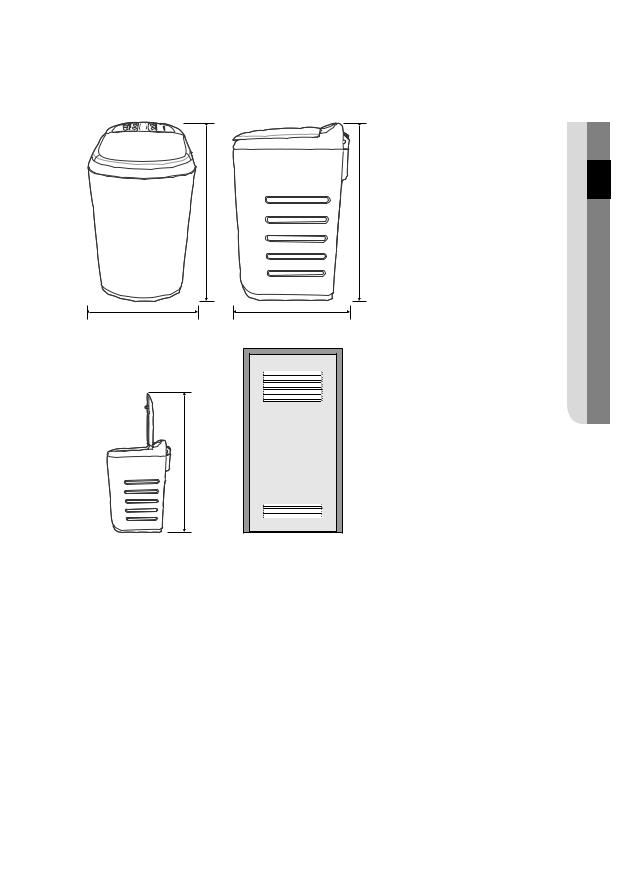
Required dimensions for installation
|
|
A 31.9 in. (809 mm) |
<![if ! IE]> <![endif]>INSTALLATION |
|
|
|
E |
3 in. (76 mm) |
|
|
|
B |
17.7 in. (450 mm) |
|
|
|
C |
21.3 in. (540 mm) |
|
|
|
D |
45.7 in. (1160 mm) |
|
A |
A |
F |
48 in.² (3100 mm²) |
|
|
|
G |
24 in.² (1550 mm²) * |
|
|
|
H |
3 in. (76 mm) |
|
B |
C |
|
E |
|
F |
|
D |
|
G |
|
H |
*) Required spacing.
**) Installing the external exhaust elbow requires more space than specified.
English - 11
Untitled-2 11 |
|
|
2014-05-26 10:51:10 |
|
|
||
|
|
|
|
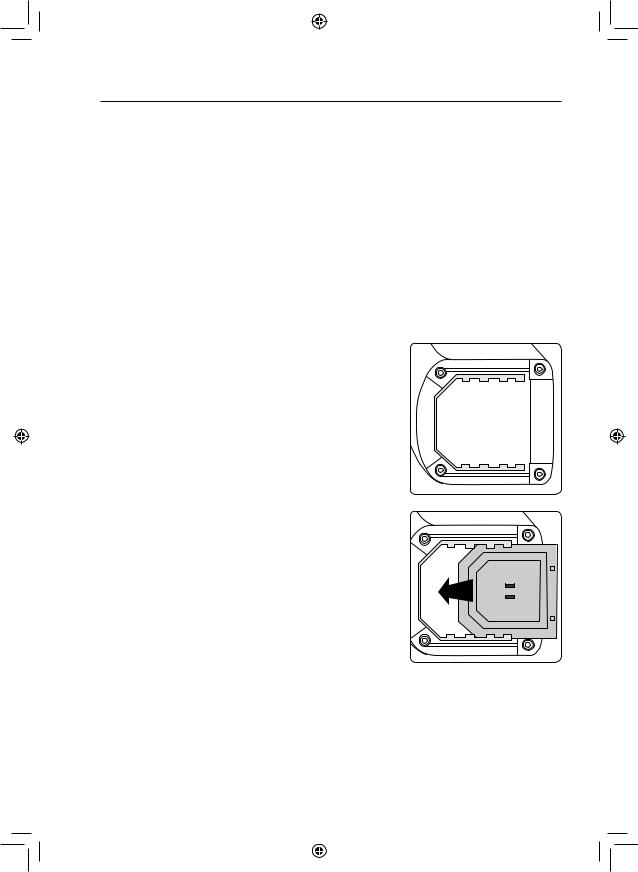
Step-by-step installation
Step 1 - Select a location
Location requirements. For the best performance:
•Install the washer on a solidly constructed floor.
•Never install the washer on a platform or weakly supported structure.
•Allow at least 4 in (10 cm) between the washer and the wall.
•Do not expose the washer to direct sunlight or rain as moisture may damage the electrical insulation, causing an electrical shock hazard.
•Provide adequate ventilation.
•Do not expose to temperatures below 32 °F or 0 °C.
•Keep away from a heat sources.
•Provide enough space so that the washer doesn’t rest on its power cord.
Step 2 – Insert the baffle board
1. Lay the washer down on its side.
•Do not lay the washer down on its front or back.
•While laying the washer down, be careful not to scratch the surface of the washer.
2.Insert the baffle board into the bottom of the washer along the guideline.
•The baffle board can reduce noise while the washer operates.
•Once the baffle board is installed, do not remove it unless necessary.
English - 12
Untitled-2 12 |
|
|
2014-05-26 10:51:10 |
|
|
||
|
|
|
|
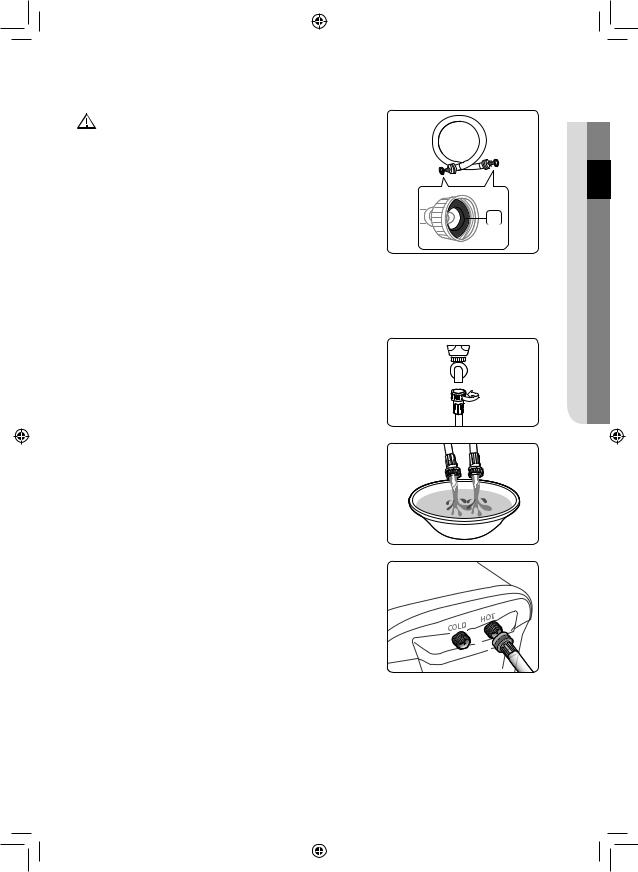
Step 3 - Connect the water supply hoses
CAUTION
•Before installing the water supply hoses, make sure there are rubber gaskets (A) inside the fittings at both ends of each new water hose. Installing the water supply hoses without rubber gaskets may cause water leakage.
•When installing the washer for the first time, make sure to use new hoses. Failing to do so may result in a water leakage or overflow and may cause property damage.
•Do not connect water supply hoses together to increase the length of the supply hose. Hoses connected this way may leak resulting in electrical shock. If a hose is too short, replace the hose with a longer, high pressure hose.
1.Connect the ends of the water supply hoses to the hot and cold water taps.
2.Tighten the fittings by hand until they are snug, and then tighten them an additional two-thirds turn with a wrench. Make sure the hoses are firmly connected by gently pulling them downwards.
3.Run water into a bucket for a few seconds to clear the water lines. Close the water taps before continuing.
4.Connect the hot-water supply hose to the hot-water supply intake at the back of the washer. Connect the cold-water supply hose to the cold-water supply intake at the back of the washer.
English - 13
<![endif]>INSTALLATION
A
Untitled-2 13 |
|
|
2014-05-26 10:51:10 |
|
|
||
|
|
|
|
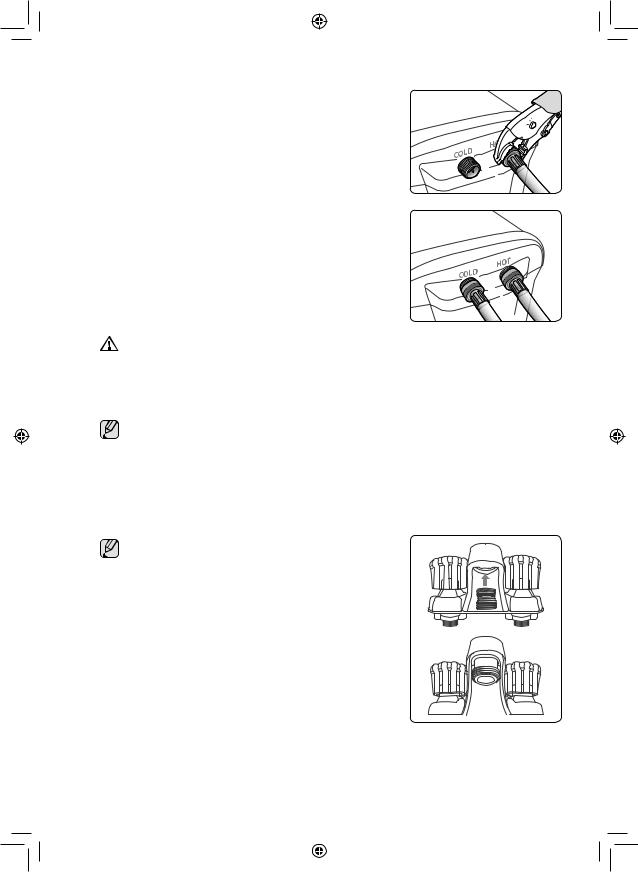
5. Tighten the fittings by hand until they are snug, and then tighten them an additional two-thirds turn with a wrench.
6.Open the hot and cold water taps, and check all the water supply intakes, water taps, and hoses for leaks.
CAUTION
•Do not over-tighten the fittings or apply tape or sealant to the taps or water supply intakes. This can damage the fittings.
•Confirm that the water supply hoses are not twisted or bent. If a hose is twisted or bent, water may leak, causing an electric shock.
•After you have connected the water supply hoses to the faucets, ensure that they are connected correctly by pulling the water supply hoses downwards.
•To ensure the correct water usage, connect both the hot and cold water taps. If either or both are not connected, a “4E” (no fill) error can occur.
•If not using the hot water supply hose, insert the water intake cap into the hot water supply intake. In this case, select the Tap Cold option to turn off the Hot indicator. Then, you can change the water temperature.
Use the provided tap connector if connecting the hose to the kitchen sink tap.
•The tap connector requires an appropriate packing for
the faucet to connect to.
•If using faucets, connect the water supply hose to the
cold water intake.
•If using faucets, make sure only cold water is supplied. Supplying both hot and cold water simultaneously may cause the water to flow backward in the drain system.
• For the Super Sanitize, Sanitize, or Self Clean cycles, cold water supply is recommended. Hot water supply involves a delay due to the cooling process.
•Make sure to close the faucet(s) when the washer is not in use.
English - 14
Untitled-2 14 |
|
|
2014-05-26 10:51:11 |
|
|
||
|
|
|
|
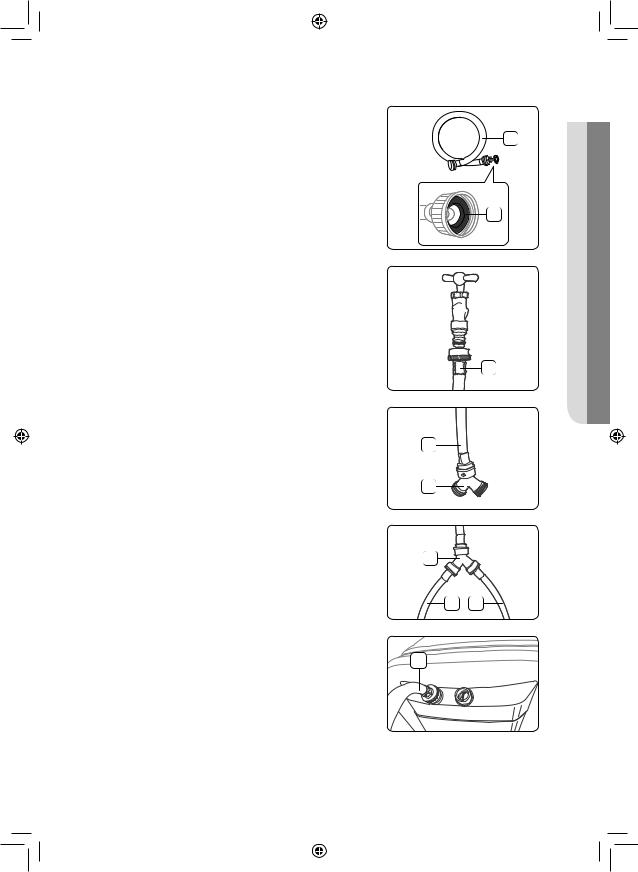
Combining with an existing washer by sharing one water tap
1.Insert the rubber washer (A) into the short inlet hose (B) as shown.
B
A
2. Connect the short inlet hoses (B) to the water taps.
Connect the hose marked “Cold” to the cold water tap and the hose marked “Hot” to the hot water tap.
B
3.Connect a Y connector (C) to the other end of each short inlet hose (B).
4.Connect the water supply hoses (D) and (E) to the Y connectors (C) as shown.
5.Connect the water supply hoses (D) to the water valves of this product as shown.
Connect the hose marked “Cold” to the cold water valve and the hose marked “Hot” to the hot water valve.
B
C
C
E D
D
English - 15
<![endif]> INSTALLATION
INSTALLATION
Untitled-2 15 |
|
|
2014-05-26 10:51:11 |
|
|
||
|
|
|
|
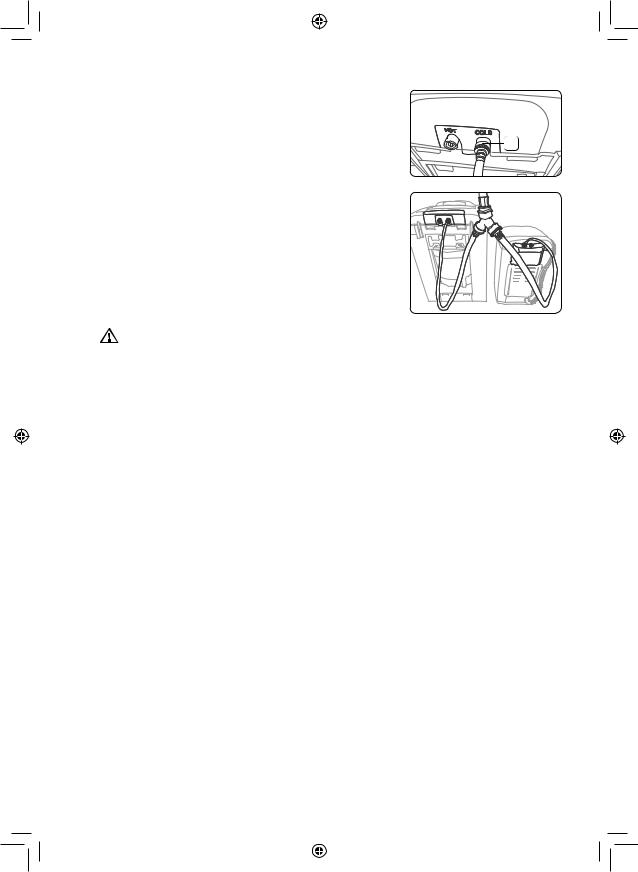
6.Connect the water supply hoses (E) to the water valves of the existing washer as shown.
Connect the hose marked “Cold” to the cold water valve and |
|
the hose marked “Hot” to the hot water valve. |
E |
7. Make sure you have connected the hoses properly as shown and check if there is a water leak.
CAUTION: When you finish washing the laundry, close the water taps. Otherwise, the following may occur:
•If the water taps are not closed or not connected properly, water may leak especially in winter.
•If the water taps are not closed, the supplied water may freeze inside the water hoses.
•The water taps or hoses could burst at a low temperature.
English - 16
Untitled-2 16 |
|
|
2014-05-26 10:51:12 |
|
|
||
|
|
|
|
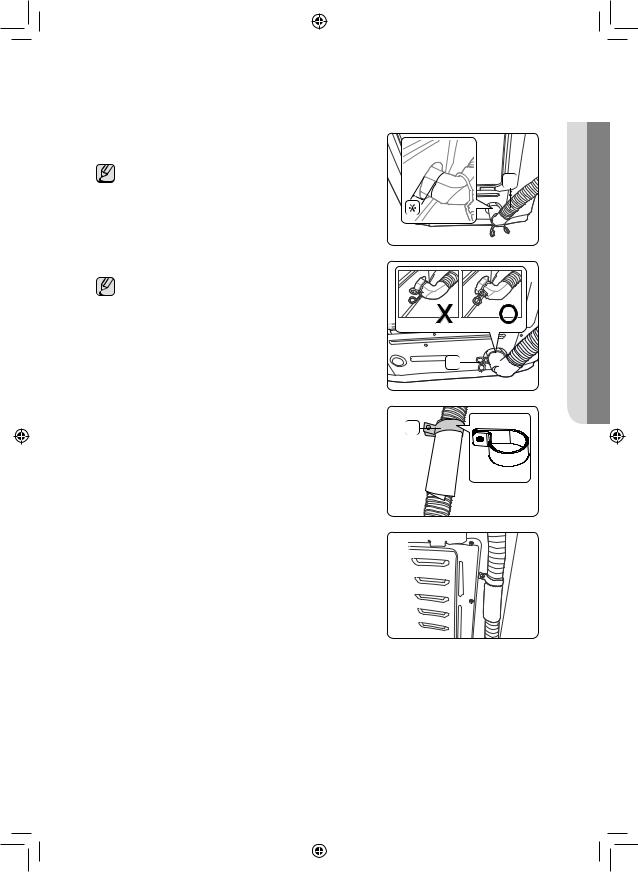
Step 4 - Connect the drain hose
Installing the drain hose
1.Connect the drain hose (A) to the case pump outlet pipe with the hose tilted at a 2 o’clock angle.
The drain hose goes over the case pump outlet pipe. |
|
Make sure that you connect the drain hose so that less |
A |
than 1/3 in. (10 mm) of the pipe remains exposed. |
|
2. Clamp the drain hose using a joint ring (B).
Make sure the joint ring is clamped with its two prongs facing the washer.
B
3. Attach the clamper (C) to the drain hose at the end of the |
|
sponge. |
C |
Make sure the clamper covers one end of the sponge. |
|
Make sure the sponge is tightened. A loose sponge may |
|
cause noise while the washer is operating. |
|
4.Insert the included screw through the screw hole in the clamper, then fix the screw to the hole on the rear right side of the frame. Tighten with a screwdriver.
English - 17
<![endif]> INSTALLATION
INSTALLATION
Untitled-2 17 |
|
|
2014-05-26 10:51:12 |
|
|
||
|
|
|
|
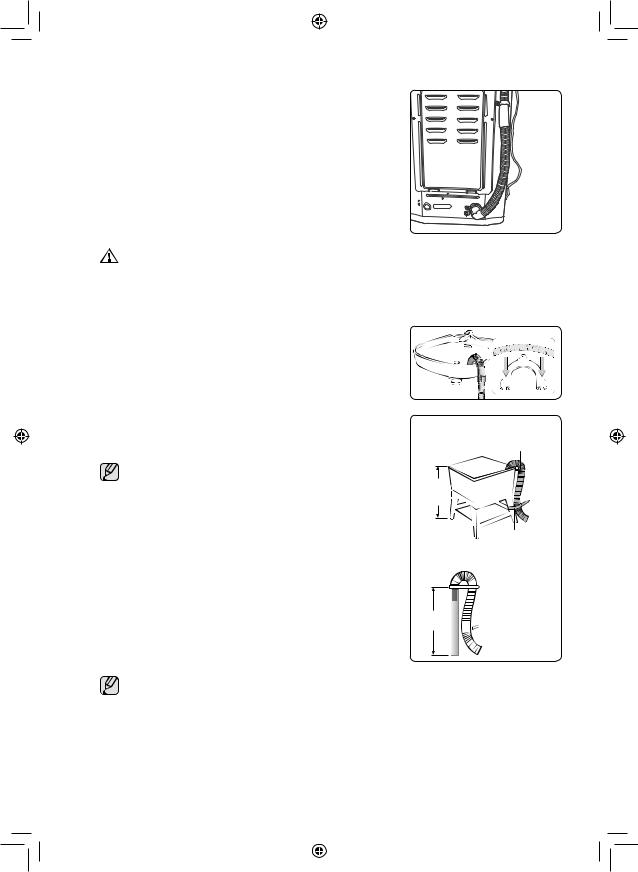
5. Make sure the drain hose is connected as shown.
CAUTION: Once you have tightened the screw on the clamper, do not loosen it. Otherwise, water may leak while the washer operates.
Position the drain hose
The end of the drain hose can be positioned in three ways:
Over the edge of a wash basin
Secure the guide to the side of the basin wall with a hook or to the tap with a piece of string to prevent the drain hose from moving.
In a standpipe or laundry tub
The standpipe must be no shorter than 39 in (99 cm) and no longer than 96 in (245 cm).
•Make sure that the connection between the drain hose and the standpipe is not airtight.
•Connect the hose guide within 4 in (10 cm) of the end of the drain hose. If the drain hose extends more than 4 in (10 cm) beyond the end of the hose guide, mold or microorganisms could spread to the inside of the washer.
Laundry tub
Hose retainer
96˝ Max
39˝ Min
Tie strap
Standpipe

 Hose retainer
Hose retainer
39˝ Min
 Tie strap
Tie strap
•The Drain Hose can be installed up to 96 in (245 cm) above the floor, maximum, but the draining capability can be reduced at this height. It can cause the washer to have an odor because of water remaining in the drain system.
•If the drain hose is installed below 39” (99cm), the syphon effect can cause water to flow back into the washer during a cycle. If this occurs, the washer displays an “4E” error.
English - 18
Untitled-2 18 |
|
|
2014-05-26 10:51:13 |
|
|
||
|
|
|
|
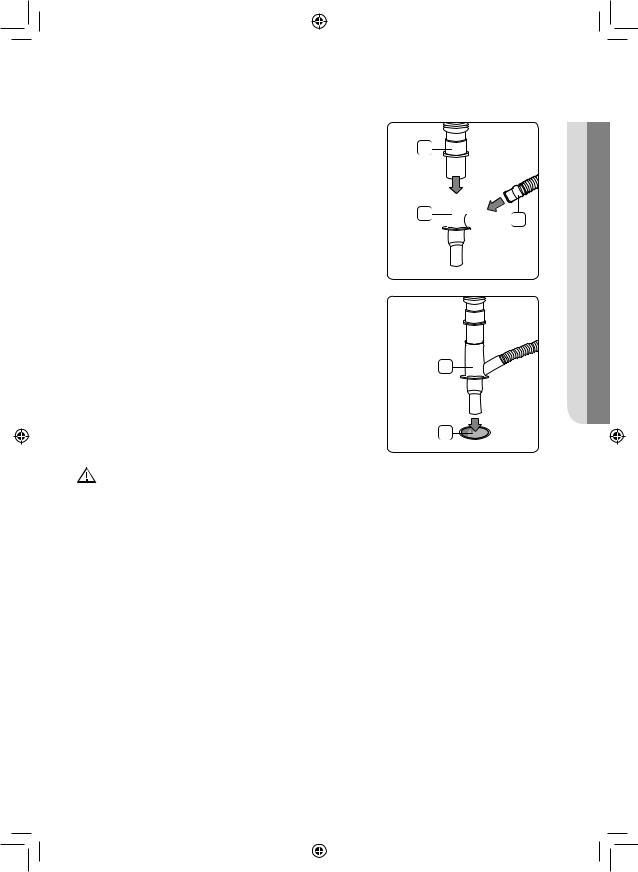
To share the drain hole with an existing washer
To share one drain hole with an existing washer, use the drain T adaptor.
1.Connect the drain hose (A) of the sanitizing washer to the drain adaptor (B) as shown.
2.Insert the drain hose (C) of the existing washer into the drain adaptor (B) as shown.
3.Insert the drain adaptor to the drain hole (D) as shown.
C
B  A
A
B
D
CAUTION
•If the drain adaptor does not fit in the drain hole, water may leak around the drain hole.
•Ensure that the drain adaptor covers the drain hole.
English - 19
<![endif]> INSTALLATION
INSTALLATION
Untitled-2 19 |
|
|
2014-05-26 10:51:13 |
|
|
||
|
|
|
|
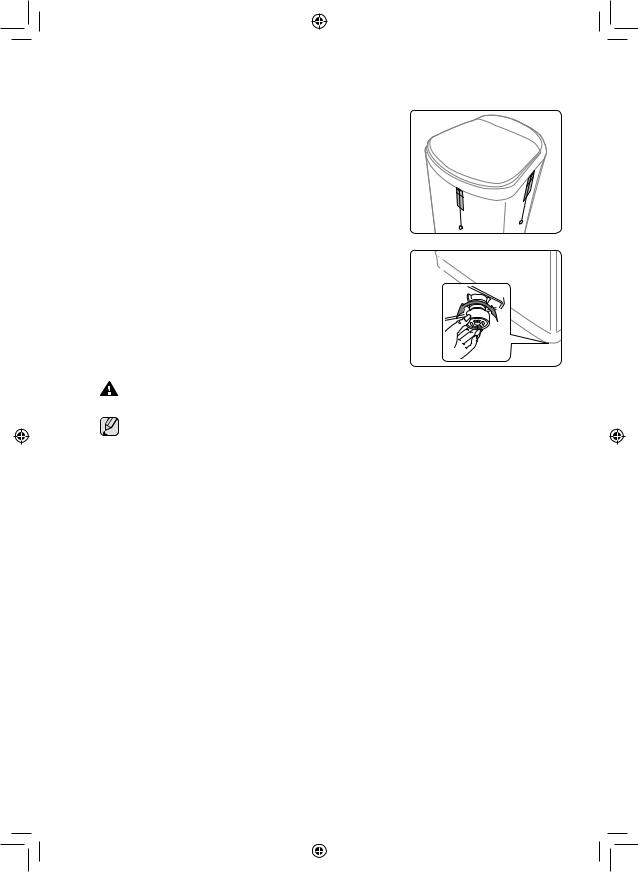
Step 5 - Level the washer
1.Choose a location with a minimum clearance of 4 in (10 cm) from the rear and side walls.
2.Attach the provided two levelling devices to the front and side, respectively. Then, check if the washer is level within
tolerance.
3.If the washer is not level, adjust the leveling feet.
4.To check if the washer is stable, press any two diagonal corners of the washer. If it shakes, adjust the leveling feet.
WARNING: Do not reach under the washer with a hand or with any metal objects while the washer is operating. This may cause a physical injury or electric shock.
After installation is complete, run the Rinse + Spin cycle to make sure the washer works properly.
English - 20
Untitled-2 20 |
|
|
2014-05-26 10:51:13 |
|
|
||
|
|
|
|
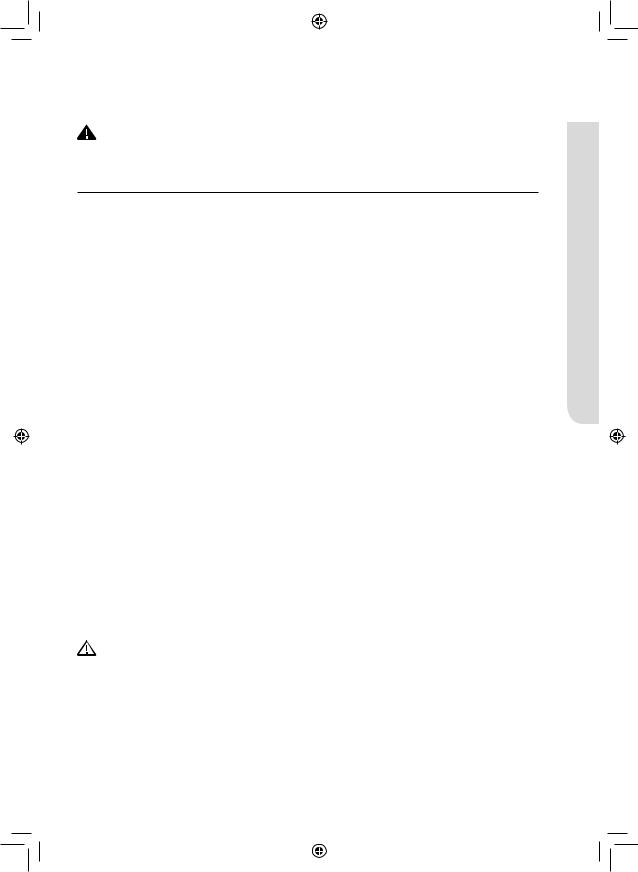
Basic operations
WARNING: To reduce the risk of fire, electric shock, or injury to persons when using your appliance, follow basic precautions, including the following:
Laundry guidelines
Carefully read the following instructions to avoid machine problems or damage to clothing.
•Check the care label on clothing before washing.
•Do not overload the tub with laundry. Excessive laundry reduces washing efficiency, increases wear and tear on clothes, and can cause increased creasing and wrinkling.
•When washing big, bulky items add some towels to improve the tumbling and spinning performance.
•Check if there are any garments that might discolor the rest of the wash. Apply a liquid detergent to a white towel and a garment, and then rub the garment with the soapy portion of the towel. If color from the garment comes off on the towel, wash the garment separately or with other items of a similar color.
•Special care is needed for scarves and imported clothes since they discolor easily. Check for stains or dirt. For stains, add some detergent to a cloth and rub the stains in one direction. Soil and dirt may rub against delicate garments, causing damage to the garments.
•For a badly soiled item, first dust it off and then wash it.
•Before washing the laundry, make sure that sleeves, collars, dress hems, and pockets are pretreated by brushing them with detergent. Wrinkle-processed clothing made of wool should be specially treated by tying them together (using thread) before washing. Remove the thread after the clothes have dried.
•Metal items on clothing may damage the tub and other laundry. Turn clothing with buttons and embroidered clothes inside out before washing them. Zip up all zippers. Otherwise, the spin basket may be damaged.
•Clothing with long strings may become entangled with other items. Make sure to fix the strings before starting a wash.
•Turn delicate items inside out before washing them.
•Wash black clothing and cotton towels separately. If these are washed together, the towels may become stained.
•If big, bulky items are not submerged in the tub water, press the Power button to stop operation and make sure they are submerged. Then, resume operation.
CAUTION
•Check all pockets before washing.
•Hair pins and coins may damage the washer.
•Check all pockets for metal items, and remove them before washing.
English - 21
<![endif]> OPERATIONS BASIC
OPERATIONS BASIC
Untitled-2 21 |
|
|
2014-05-26 10:51:13 |
|
|
||
|
|
|
|

Do NOT wash
•Clothing that is easily damaged by water.
•Neckties, brassieres, jackets, suits and coats that are made mostly of rayon and other kinds of blended fabrics that can be easily damaged (e.g. shrinkage and discoloration).
•Wrinkle-processed, embossed, or resin processed products that are easily damaged when just soaked in water.
•Easily discolored products made of cotton or wool, wrinkled silk, leather products, leather accessory, leather ornamented clothes and their accessories.
•Waterproof clothing (e.g. ski wear, diaper covers, and mats/rugs). This may cause the laundry to be ejected or cause the washer to vibrate abnormally, which may result in personal injury or damage to the washer, the floor, or the clothing. When the tub rotates, water may become trapped in the waterproof clothing or fabric and can collect in a corner, causing abnormal vibrations. In addition, the laundry rises and may be ejected and cause personal injury.
Laundry net
•Use only commercial laundry nets.
•Place delicate clothes in a laundry net.
•Cashmilon garments and garments that are large and lightweight (e.g. lace decorated clothing, lingerie, nylon stockings, synthetic fabrics, etc.) may rise to the top of the washer and damage clothing and the washer. Use a laundry net or wash these items separately.
•Place long stringed and lace decorated clothing, baby bed cover sheets, and woolen clothes into a laundry net before washing them.
English - 22
Untitled-2 22 |
|
|
2014-05-26 10:51:13 |
|
|
||
|
|
|
|
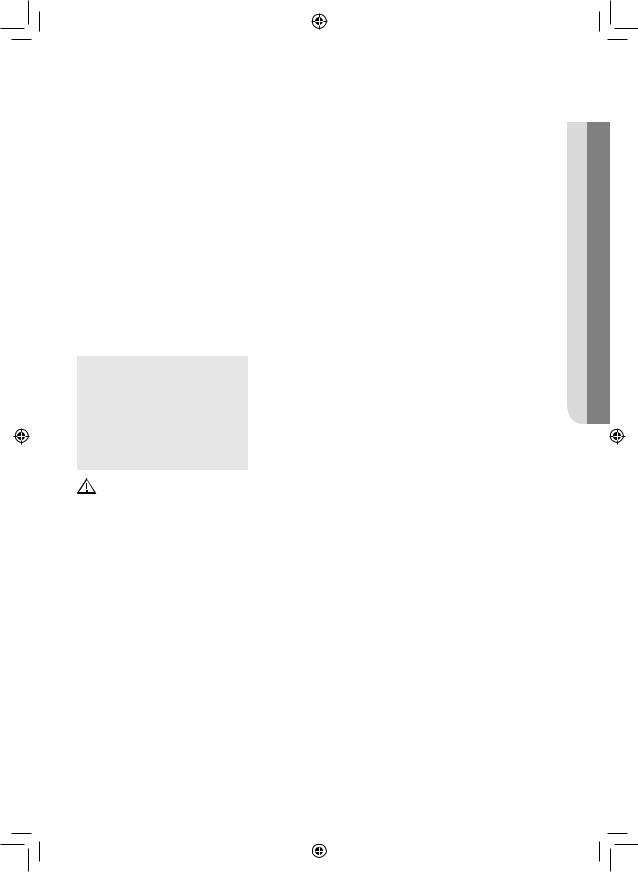
Checklist
Sorting & pretreatment
• Sort the laundry according to type, color, and the degree of soiling (heavily soiled, color fast, |
<![if ! IE]> <![endif]>BASIC |
|
delicate clothing, etc.). |
|
|
|
|
|
• Keep accessories in place and empty the pockets. |
<![if ! IE]> <![endif]>OPERATIONS |
|
• If any of the clothes are damaged, fix them before washing. |
|
|
|
|
|
• Check if buttons are firmly in place. |
|
|
|
|
|
• Before washing, pre-treat any stubborn stains. |
|
|
• If any laundry is caught by the door lid, clothing may tear and cause water leakage. Make sure |
|
|
|
|
|
no laundry can be caught in the door before closing the door. |
|
|
Before doing a sanitizing wash
Sort and wash the laundry by color.
•Do not wash laundry that may become discolored by a sanitizing wash.
•Do not use a sanitizing wash for delicate clothing such as woolen items and lingerie.
Do not put these items in a sanitizing wash:
Cottons |
Easily discolored T-shirts. |
|
Embroidered T-shirts with knitted fiber. |
||
|
||
|
|
|
Linens |
Wrinkle resistant clothing with synthetic mixed fiber. |
|
|
|
|
Woolen or Silk Items |
Cold water wash only. |
|
|
|
|
Synthetics |
Tops, shirts, stockings. |
|
|
|
|
Acetate Fiber Items |
Do not put in a sanitizing wash. |
|
|
|
•Do not use this product and other heating equipment at the same time.
•The temperature of a sanitizing wash cycle varies according to the environment.
English - 23
Untitled-2 23 |
|
|
2014-05-26 10:51:13 |
|
|
||
|
|
|
|
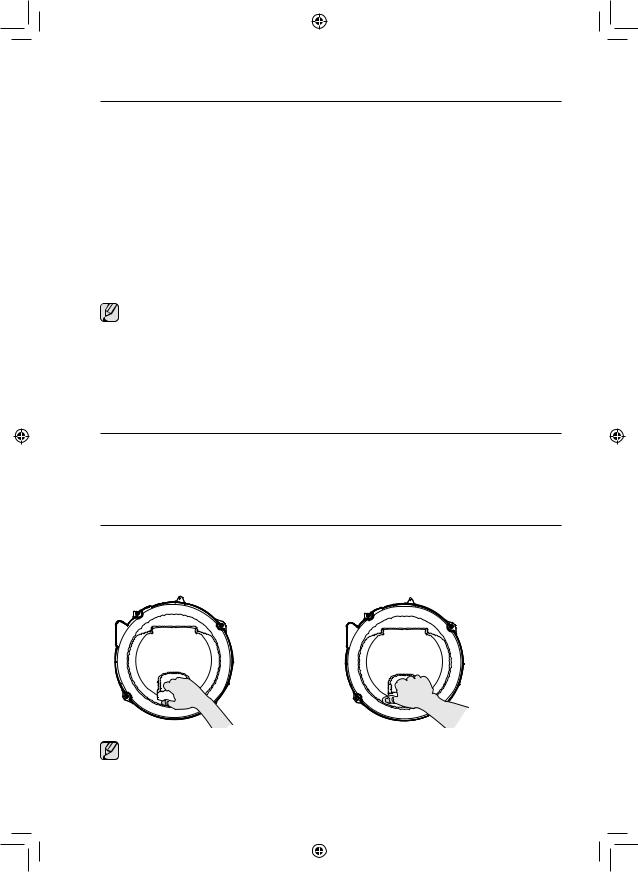
Detergent types and usage
•Adding more detergent doesn’t increase performance. Rather, too much detergent generates too many bubbles, reducing the rinse effect and causing environmental pollution.
•Powder detergent residue may be left over in the cleaned laundry, causing bad odors. If using powder detergent, fully rinse the laundry.
•Bleach is strongly alkaline and can damage the laundry.
•Do not use a soap type of detergent whether it’s a solid type or powder type. Using these types of detergent may cause the following:
•A white residue of the detergent may remain on the cleaned laundry.
•Some amount of the detergent may coagulate, causing bad odors on or discolor the laundry.
•The tub can be badly contaminated with the detergent residue, which contaminates the laundry in turn.
•The amount of fabric softener specific to wool or baby clothing differs depending on the manufacturer of the fabric softener. Make sure you are using the standard or recommended amount of softener by the manufacturer.
•Reduce the amount of detergent if the washer generates excessive amounts of bubble while in operation or after washing is complete.
•Using liquid detergent is recommended.
When to add fabric softener
•An alarm sounds for 20 seconds immediately before the last rinse cycle in order to remind users of adding fabric softener to the tub.
•For the Rinse + Spin cycle, fabric softner must be input in advance.
Handling the secure door
Open the secure door
Gently lift up the handle to open the door.
Close the secure door
Lower the door until it contacts the built-in magnet.
If the secure door is not firmly closed, the washer may emit noises during a spin cycle, or steam may overflow while sanitizing the laundry. Make sure to firmly close the secure door.
English - 24
Untitled-2 24 |
|
|
2014-05-26 10:51:13 |
|
|
||
|
|
|
|
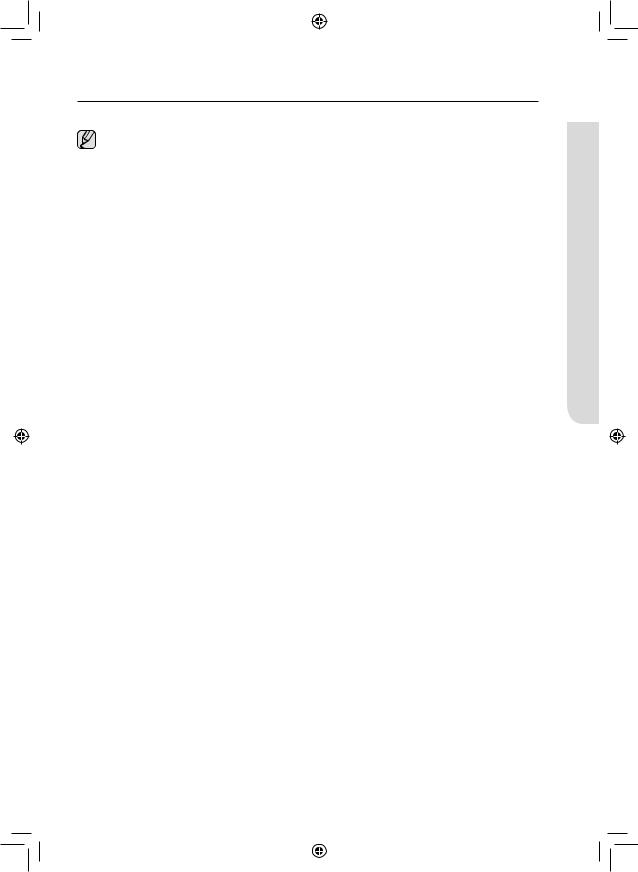
About the sanitizing wash cycle
The sanitizing wash cycle sanitizes clothes and helps remove stains.
How can a sanitizing wash remove stains more effectively?
While the laundry is being sanitized, the laundry’s fibres fold and naturally rub each other to facilitate the removal of stubborn stains. Also, the high temperature helps soften the material of the laundry, and enhances the performance of the detergent. Stains on the surface of the laundry are easily removed by the steam and bubbles that are generated by the high temperatures of the sanitizing wash cycle.
Sterilization
The sanitizing wash has a sterilization effect. Odors and most of the bacteria that cause skin allergies are removed by the sanitizing cycle. Keeps your clothes fresh and clean.
Bleaching
Colors become brighter as stubborn stains are removed by the sanitizing cycle.
Washing effect
The higher the water temperature, the better the washing effect.
The effects of a sanitizing wash cycle are 60% better than a normal wash. Even with a half of the normal amount of detergent, the effects of a sanitizing wash increase up to 20%
Sanitizing wash instructions
•Use caution during a sanitizing wash because the water temperature is very high.
•To drain the water safely, do not select a high water level for a sanitizing wash. Do not put more than 1.5 kg (3 lb) of laundry into the tub. If you put more than 3 lb. (1.5 kg) of laundry into the tub, the clothes’ fibers can be damaged. (Underwear: 4.5 oz/130 g; short pants: 1.75 oz/50 g; socks: 1.75 oz/50 g; normal towels: 5.25 oz/150 g; bath towels: 10.5 oz/ 300 g)
•Do not supply hot water through the cold water valve. Operate the washer only after the cold water valve is closed. For safety reasons, add cold water to cool down the hot water while draining.
•Time required to run the sanitizing wash cycle depends on the water temperature.
•The washer is designed for a sanitizing wash. Add only cold water to the hot water to cool it down when the cycle is complete.
•If only hot water is supplied, or the water hoses are connected incorrectly (hot to cold and cold to hot), the washer won’t drain the water. If this occurs, an alarm will sound and the washer will display an error code.
•The sanitizing wash cycle starts only when the door is closed.
•Once the cycle starts, the water level cannot be changed nor can hot water be added.
<![endif]> OPERATIONS BASIC
OPERATIONS BASIC
English - 25
Untitled-2 25 |
|
|
2014-05-26 10:51:13 |
|
|
||
|
|
|
|
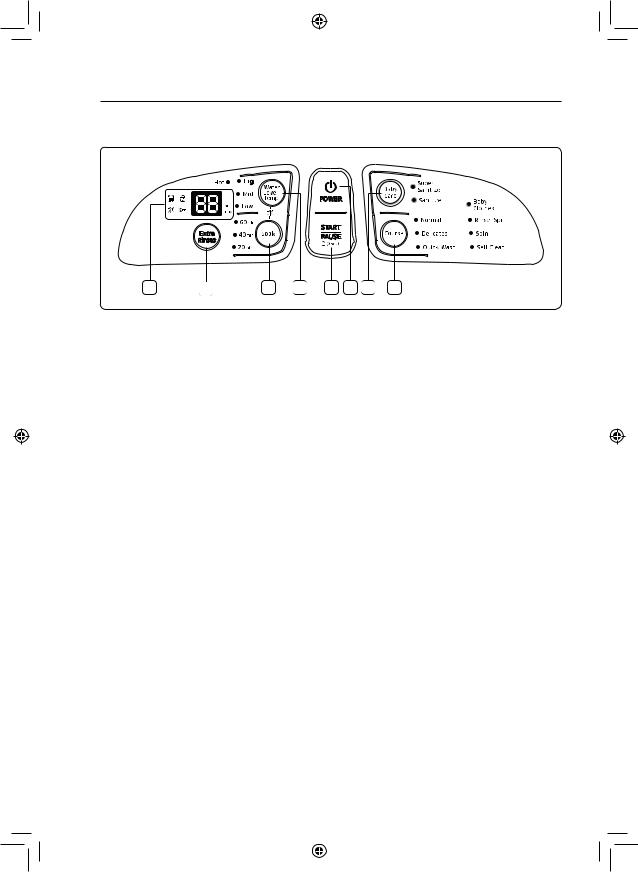
Getting started
Control panel
1 |
2 |
3 |
4 |
5 |
6 |
7 |
8 |
1.Display
Displays the remaining washing time.
Displays an error message if a problem occurs.
2.Extra Rinses
Press this button to perform a rinse-only cycle or to change the number of rinse cycles. You can set up to 6 rinse cycles.
3.Soak
Press this button to do a soak wash.
According to the selected cycle, the soak time is determined by the minute.
4.Water Level/Temp.
Press this button to select a water level from High, Mid, and Low.
5.START/PAUSE
Press this button to start or stop an operation.
To change the cycle while the washer is operating, press this button to stop the operation. Then, change the cycle, and press the button again.
6.POWER
Press this button once to turn on the washer. Press it again to turn off the washer.
English - 26
Untitled-2 26 |
|
|
2014-05-26 10:51:14 |
|
|
||
|
|
|
|
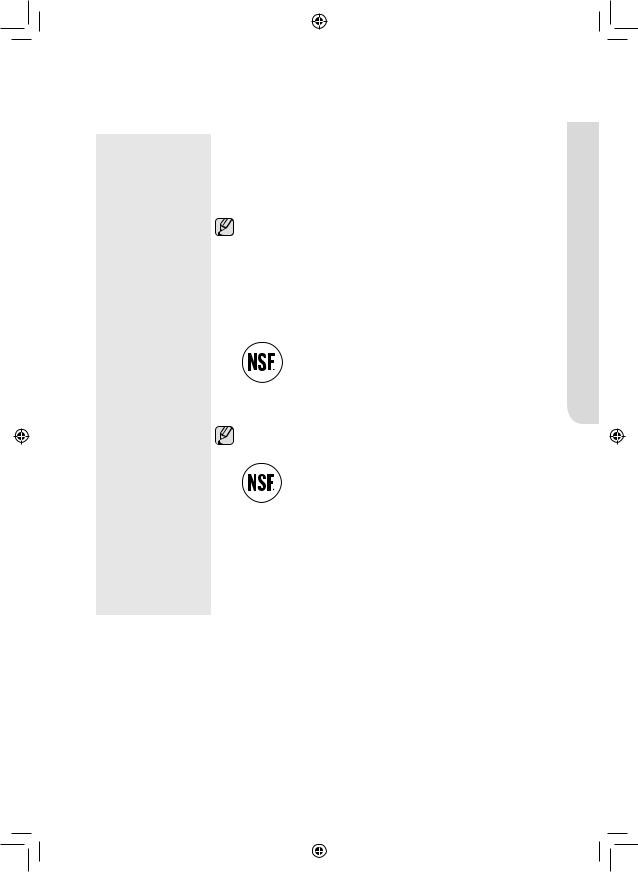
7.Baby Care
These cycles clean items such as baby clothes and underwear that require additional rinse cycles for sanitary purposes without damaging the fabric.
|
For sterilizing and bleaching underwear and cloth diapers. |
||||
|
The laundry is heated up to the sanitizing point, maintained at that |
||||
|
temperature for a pre-determined period of time, and then goes |
||||
|
through 3 rinse cycles. |
||||
|
(Allowable load : less than 3.45 lbs.) |
||||
|
When selecting this cycle, the water heats to an extra high |
||||
|
temperature to remove 99.9% of certain bacteria typically |
||||
|
found on clothing, bedding, or towels. This certification is |
||||
|
conducted by NSF International, an independent third-party |
||||
|
testing and certification organization. Please check the |
||||
|
garment care label to avoid garment damage. Only sanitizing |
||||
Super Sanitize |
cycles have been designed to meet the requirements of this |
||||
protocol for sanitization efficacy. |
|||||
|
|
|
|
|
|
|
|
NSF Protocol P172 |
|
|
|
|
|
Sanitization Performance of Residential and |
|
|
|
|
|
Commercial, Family-Sized Clothes Washers |
|
|
|
|
|
|
|
|
|
|
For removing dust mites, pet dander, or other allergic substances of |
||||
|
the fabric. |
||||
|
Only this cycle has been designed to meet the requirement of |
||||
|
P351 for allergy reduction efficacy. |
||||
|
|
|
|
||
|
|
NSF Protocol P351 |
|
||
|
|
Allergen Reduction Performance of Residential and |
|
||
|
|
Commercial,Family-Sized Clothes Washers |
|
||
|
|
|
|
|
|
|
|
|
|
|
|
Sanitize |
Sterilizes the laundry in power saving mode. |
||||
(Allowable load : less than 3.45 lbs.) |
|||||
|
|||||
|
|
|
|
|
|
|
For newborn baby clothing (including diapers), infant clothing, and |
||||
Baby Clothes |
organic clothing that needs extreme sanitization without being |
||||
damaged. |
|||||
|
|||||
|
(Allowable load : less than 3.45 lbs.) |
||||
|
|
|
|
|
|
English - 27
<![endif]> OPERATIONS BASIC
OPERATIONS BASIC
Untitled-2 27 |
|
|
2014-05-26 10:51:14 |
|
|
||
|
|
|
|
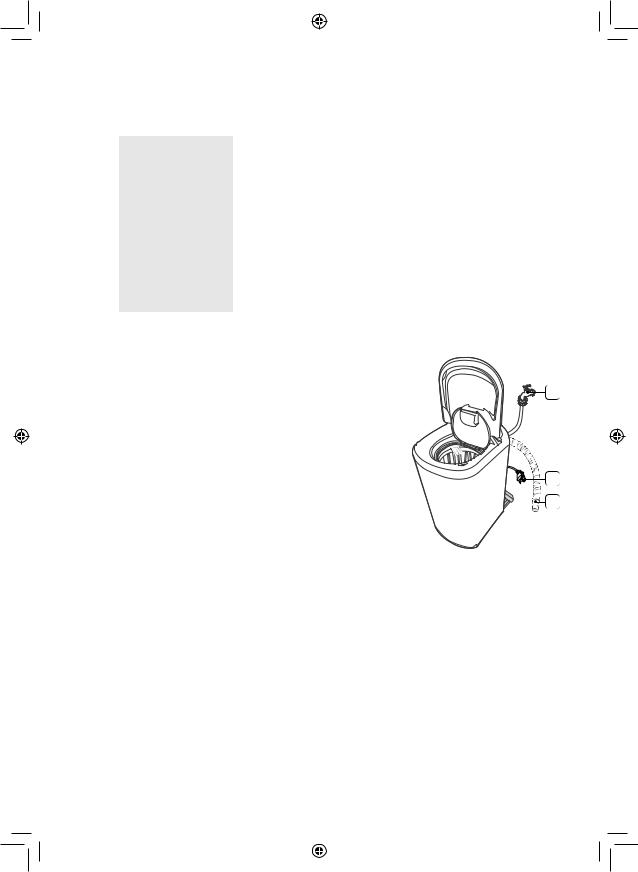
8.Course (Cycle)
Select an appropriate cycle for the laundry type.
The tumbling pattern and the spinning speed depend on the selected cycle..
Normal |
Default cycle. |
|
|
|
|
Delicates |
For washing delicate clothing such as lingerie and underwear. |
|
|
|
|
|
For washing a small amount of slightly stained laundry in a short |
|
Quick Wash |
time. |
|
|
(Allowable load : less than 3.45 lbs.) |
|
|
|
|
Rinse + Spin |
For laundry that only needs rinsing or laundry you want to rinse |
|
without a rinse-added fabric softener. |
||
|
||
|
|
|
Spin |
Select this cycle to perform a spinning-only cycle. |
|
|
|
|
Self Clean |
This cycle cleans and sanitizes the tub. Never put clothes in the tub |
|
when running a Self Clean cycle. |
||
|
||
|
|
Before you start
1. Open the water tap.
Check if the water supply hoses are correctly connected to |
|
the corresponding tap (cold/hot water). |
1 |
2. Plug the power cable into a 120 V wall socket.
3. Ensure that the drain hose is placed as instructed.
2
3
English - 28
Untitled-2 28 |
|
|
2014-05-26 10:51:14 |
|
|
||
|
|
|
|
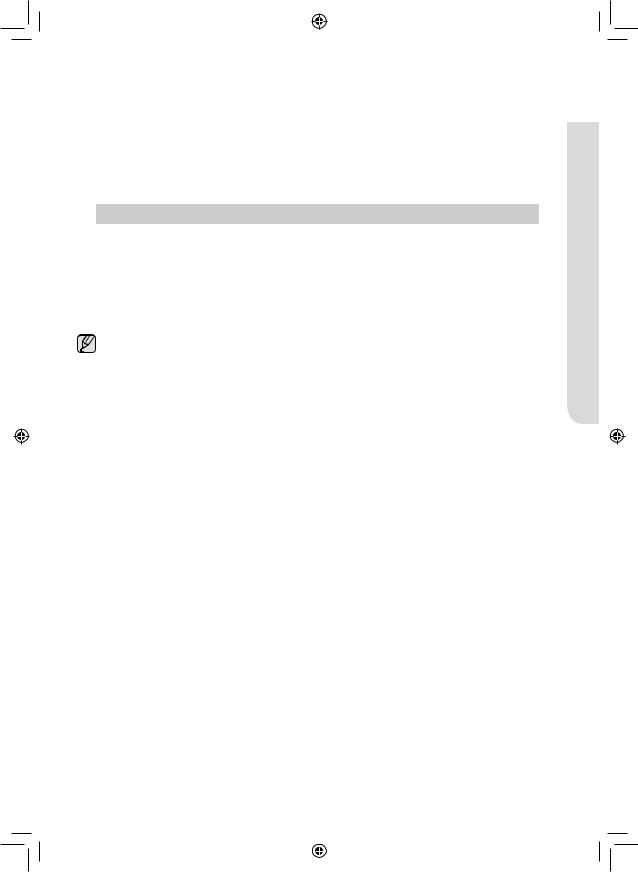
Washing for the first time
1.Place the laundry into the tub, add an appropriate amount of detergent, and then close the door. For effective washing, add detergent and bleach into the tub before adding the laundry.
2.Press the POWER button.
3.Press the Baby care or Course (Cycle) button to select a cycle.
4.Press the Water Level/Temp. button to specify the water level according to the laundry load, and then select the water supply type (cold or hot water).
High |
Mid |
Low |
|
|
|
3.90 lbs or less |
3.45 lbs or less |
3.00 lbs or less |
|
|
|
The default water level is set for each cycle, and the default water supply type is cold water.
5.Press the Extra Rinses button to select the number of rinse cycles.
(The number of rinse cycles cannot be changed during the last rinse cycle or the spin cycle.)
6.Close the door.
7.Press the START/PAUSE button.
•To change the wash cycle, press the START/PAUSE button, select a cycle, then press the START/PAUSE button again.
•If you want to add the soak cycle, press the Soak button before starting the wash. The Soak cycle is not available for the following cycles: Delicates, Quick Wash, Rinse + Spin, Spin, or Self Clean.
English - 29
<![endif]> OPERATIONS BASIC
OPERATIONS BASIC
Untitled-2 29 |
|
|
2014-05-26 10:51:14 |
|
|
||
|
|
|
|

Water level and temperature
For economic and effective washing, specify a proper water level and a water supply type. The default water level is High, and the default supply type is Hot water.
•Press the Water Level/Temp. button to select a water level and a water supply type: High/Cold > High/Hot > Mid/Cold > Mid/Hot > Low/Cold > Low/Hot > High/Cold
•If you change the water level before the water fills up to the preset level, the washing time changes accordingly.
CAUTION: To prevent damage to clothing, check the care label on the clothing.
Child Lock
Child Lock is designed to prevent children from accidently starting, stopping, or resetting the washer.
•Once the Child Lock is set, it remains set until you release it manually. Turning off the washer will not release this function.
•Press and hold the START/PAUSE button for more than 3 seconds to set or release the Child Lock. The Child Lock indicator  turns on or off accordingly.
turns on or off accordingly.
Mute
•When the washer enters the mute mode, the Mute indicator  turns on.
turns on.
•Press and hold both the Water Level/Temp. and the Soak buttons to mute or unmute the washer.
Self Clean
We recommend that you clean the tub using the Self Clean cycle regularly for hygienic reasons.
1.Press the POWER button.
2.Press the Course (Cycle) button to select Self Clean.
3.Press the Water Level/Temp. button. By default, the water level is fixed to Mid. You can select only hot or cold water.
4.Press the START/PAUSE button.
CAUTION: Do not use any cleaning agents to clean the drum. Chemical residues in the drum degrade washing performance.
English - 30
Untitled-2 30 |
|
|
2014-05-26 10:51:14 |
|
|
||
|
|
|
|
